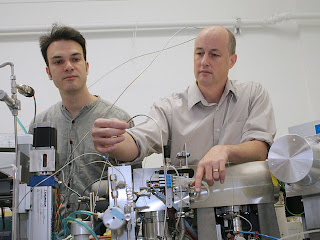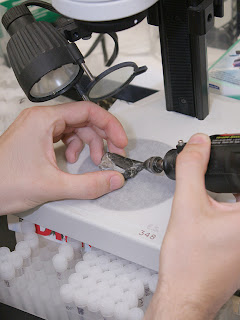Scientists have many questions about how the internal condition of dinosaurs (not preserved in fossilized remains) may have influenced the way those creatures lived. One of the conditions in question is whether or not dinosaurs were cold blooded or warm blooded and what were their internal temperatures. But now a team of researchers from the California Institute of Technology believe they have developed a method by which they can identify the internal temperature of dinosaurs based on fossilized teeth.
 |
| Caltech Geochemists Rob Eagle (L) and John Eiler |
The researchers, led by postdoctoral researcher Robert Eagle, studied isotopic concentrations in 11 fossilized teeth from sauropods (the long-tailed, long-necked dinosaurs). The teeth were recovered from sites in Tanzania, Wyoming and Oklahoma and belonged to Brachiosaurus and Camarasaurus dinosaurs.
The method used for this analysis is called a clumped isotope technique. The concentrations of the isotopes carbon-13 and oxygen-18 in bioapatite, a mineral found in teeth and bone. How often these isotopes bond with each other (clump, if you will) hinges on the temperature. The lower the temperature the more the isotopes tend to bond with each other. So, the researchers measured how these isotopes clumped together to determine the environmental (in this instance the internal condition of the dinosaur) temperature. At least, the temperature of the tooth.
The study allowed the researchers to estimate the temperature of Brachiosaurus to 100.8 degrees Fahrenheit and the temperature of Camarasaurus to 96.3 degrees Fahrenheit. This is warmer than living and extinct reptile species (like crocodiles) but is cooler than birds both of which are believed to be modern descendants of the dinosaurs. According to the researchers the measurements are accurate to within one or two degrees.
 |
| Drilling a Camarasaurus tooth |
Prior to this research, the best way to evaluate the internal temperature of dinosaurs was to infer what would be most likely based on the dinosaur’s behavior and physiology. However, researchers sought a method that would be more specific. That’s not to say the researcher’s new method is infallible. While they have made big claims about it being “bullet proof,” it remains to be seen whether this method is the most accurate and effective.
The study led the Caltech researchers to conclude that dinosaurs were warm blooded (have an internal mechanism to moderate body temperature), but they warn that the issue is actually more complicated that just temperature readings. Even if the creatures were cold blooded and relied on their environment for warmth, they still could have had very warm bodies. Unfortunately knowing the temperature of the teeth don’t answer all of the remaining questions about dinosaur temperature.
The scientists hope to expand upon this study to include analysis of the teeth of other species of extinct vertebrates, in addition to determining the internal temperatures of small and young dinosaurs that may reveal more about how temperature affected the way these creatures lived. The research paper was published in ScienceExpress. More information (from a press release) is available from Caltech and in the following video (which were both used as sources for this post.)